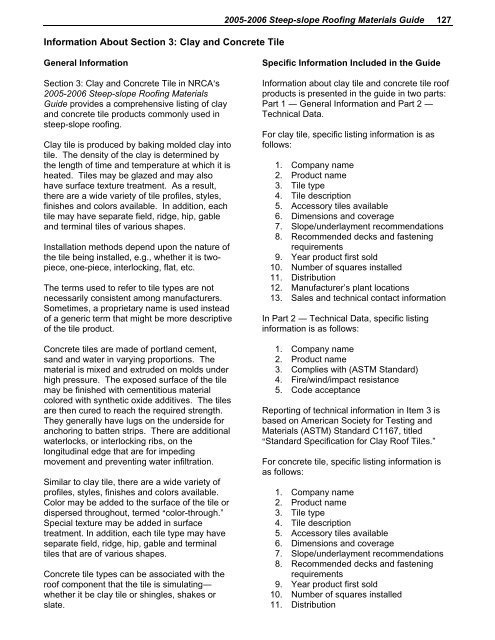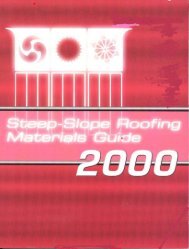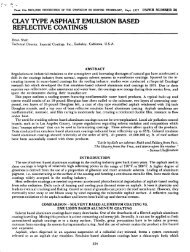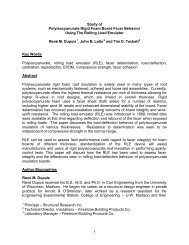2005-2006 steep-slope roofing materials guide - National Roofing ...
2005-2006 steep-slope roofing materials guide - National Roofing ...
2005-2006 steep-slope roofing materials guide - National Roofing ...
Create successful ePaper yourself
Turn your PDF publications into a flip-book with our unique Google optimized e-Paper software.
Information About Section 3: Clay and Concrete Tile<br />
General Information<br />
Section 3: Clay and Concrete Tile in NRCA=s<br />
<strong>2005</strong>-<strong>2006</strong> Steep-<strong>slope</strong> <strong>Roofing</strong> Materials<br />
Guide provides a comprehensive listing of clay<br />
and concrete tile products commonly used in<br />
<strong>steep</strong>-<strong>slope</strong> <strong>roofing</strong>.<br />
Clay tile is produced by baking molded clay into<br />
tile. The density of the clay is determined by<br />
the length of time and temperature at which it is<br />
heated. Tiles may be glazed and may also<br />
have surface texture treatment. As a result,<br />
there are a wide variety of tile profiles, styles,<br />
finishes and colors available. In addition, each<br />
tile may have separate field, ridge, hip, gable<br />
and terminal tiles of various shapes.<br />
Installation methods depend upon the nature of<br />
the tile being installed, e.g., whether it is twopiece,<br />
one-piece, interlocking, flat, etc.<br />
The terms used to refer to tile types are not<br />
necessarily consistent among manufacturers.<br />
Sometimes, a proprietary name is used instead<br />
of a generic term that might be more descriptive<br />
of the tile product.<br />
Concrete tiles are made of portland cement,<br />
sand and water in varying proportions. The<br />
material is mixed and extruded on molds under<br />
high pressure. The exposed surface of the tile<br />
may be finished with cementitious material<br />
colored with synthetic oxide additives. The tiles<br />
are then cured to reach the required strength.<br />
They generally have lugs on the underside for<br />
anchoring to batten strips. There are additional<br />
waterlocks, or interlocking ribs, on the<br />
longitudinal edge that are for impeding<br />
movement and preventing water infiltration.<br />
Similar to clay tile, there are a wide variety of<br />
profiles, styles, finishes and colors available.<br />
Color may be added to the surface of the tile or<br />
dispersed throughout, termed Acolor-through.”<br />
Special texture may be added in surface<br />
treatment. In addition, each tile type may have<br />
separate field, ridge, hip, gable and terminal<br />
tiles that are of various shapes.<br />
Concrete tile types can be associated with the<br />
roof component that the tile is simulating―<br />
whether it be clay tile or shingles, shakes or<br />
slate.<br />
<strong>2005</strong>-<strong>2006</strong> Steep-<strong>slope</strong> <strong>Roofing</strong> Materials Guide 127<br />
Specific Information Included in the Guide<br />
Information about clay tile and concrete tile roof<br />
products is presented in the <strong>guide</strong> in two parts:<br />
Part 1 ― General Information and Part 2 ―<br />
Technical Data.<br />
For clay tile, specific listing information is as<br />
follows:<br />
1. Company name<br />
2. Product name<br />
3. Tile type<br />
4. Tile description<br />
5. Accessory tiles available<br />
6. Dimensions and coverage<br />
7. Slope/underlayment recommendations<br />
8. Recommended decks and fastening<br />
requirements<br />
9. Year product first sold<br />
10. Number of squares installed<br />
11. Distribution<br />
12. Manufacturer’s plant locations<br />
13. Sales and technical contact information<br />
In Part 2 ― Technical Data, specific listing<br />
information is as follows:<br />
1. Company name<br />
2. Product name<br />
3. Complies with (ASTM Standard)<br />
4. Fire/wind/impact resistance<br />
5. Code acceptance<br />
Reporting of technical information in Item 3 is<br />
based on American Society for Testing and<br />
Materials (ASTM) Standard C1167, titled<br />
AStandard Specification for Clay Roof Tiles.”<br />
For concrete tile, specific listing information is<br />
as follows:<br />
1. Company name<br />
2. Product name<br />
3. Tile type<br />
4. Tile description<br />
5. Accessory tiles available<br />
6. Dimensions and coverage<br />
7. Slope/underlayment recommendations<br />
8. Recommended decks and fastening<br />
requirements<br />
9. Year product first sold<br />
10. Number of squares installed<br />
11. Distribution





